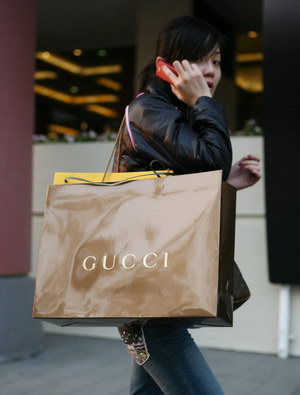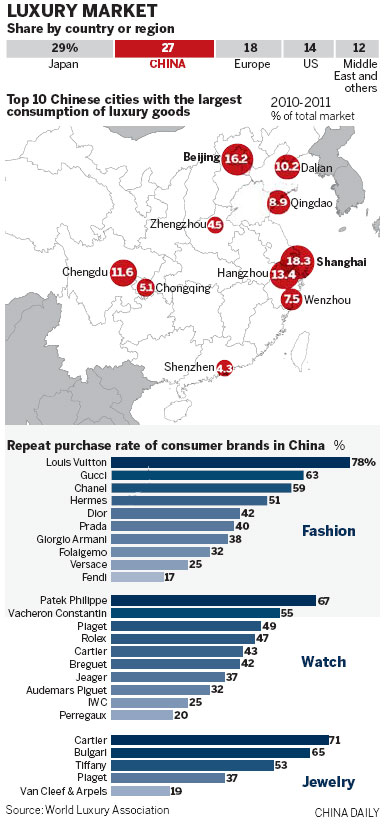Sitting in the lap of luxury
Updated: 2011-07-18 09:05
By Shi Jing (China Daily)
|
|||||||||||
SHANGHAI - As if tuned to the tempo of the conductor's baton, the orchestra of the world's top fashion houses is playing a crescendo of price increases with surprising gusto.
 |
|
Shopping for designer goods. Luxury brand owners believe that raising the price of their products will promote brand exclusivity and help their growth. [Photo/Agencies] |
The well-orchestrated move has shocked observers from New York to Shanghai, coming, as it does, at a time when demand for a pair of 3,600 yuan ($557) jeans from Prada SpA or a 9,600 yuan bag by Gucci SpA is widely expected to be doused by the unfolding debt crisis in Europe and the threat of a double-dip recession in the United States. As such, the orchestra should rather be playing diminuendo.
However, the Chinese audience is crying out for a march. While consumers in Japan, the United States and Europe are scrimping on luxury goods, the swelling ranks of big spenders in China are taking in whatever the "haute" houses in Paris or Milan can serve up. With demand underscored by an army of Chinese consumers, luxury brands feel no constraint in boosting their prices to cover rising costs and foreign exchange losses.
The price of an Amazona bag from the Madrid-based luxury clothing and accessories brand Loewe (a division of LVMH Group) soared to 22,000 yuan from 18,000 yuan in one week, a rise of more than 20 percent.
And Loewe is not alone. Its French peer Chanel SA has come out with an even more stunning price list since April 28. The price for a classic Maxi flap bag, for example, has been raised to 41, 000 yuan from 31,500 yuan, up more than 30 percent. In Hong Kong, the price for the same bag has increased to HK$43,200 ($5,544) from HK$31,800, a rise of more than 35 percent.
Known as "Jeweler to Kings, King of Jewelers", the Paris-based luxury jeweler Cartier SA assumed its role in this price-rise symphony as early as March 17. A gold ring from the company's Love series has seen its price surge to 6,800 yuan from 6,100 yuan, up about 11 percent.
And while Cartier fans have not fully recovered from this unexpected price increase, it is now widely rumored that price will surge again this month.
Indeed, almost all the big European luxury names, including LVMH Group (Louis Vuitton), Dior SA, Burberry Group Plc and Celine SA, have raised their prices by between 5 and 15 percent on average in the first five months of this year.
The depreciation of the euro is considered one of the main reasons for these increases, according to a recent report released by the World Luxury Association (WLA), an international nonprofit organization that specializes in market research and the management of luxury brands.
Between the beginning of 2010 and the end of May this year, the euro has depreciated by 20 percent against the yuan. Although the depreciation has brought these brands unprecedented high sales from overseas, the values of the brands themselves have shrunk severely. Therefore, raising the price of the products is a way of minimizing the losses from exchange-rate depreciation.
Meanwhile, the report also pointed out that prices for luxury brands usually increase by between 10 and 30 percent on an annual basis. However, whether it's an increase or decrease, the prices are changed before new products are put on the market, or once every three months.
Although it is normally believed that an increase in price may lead to a loss of customers, 95 percent of the luxury brand companies interviewed by the WLA, including Louis Vuitton and Gucci, have shown a positive attitude, because they believe that higher prices signal greater exclusivity and help with the growth of the brand.
The luxury giants' confidence in the market has been boosted by sales in China. The Sweden-based tax reimbursement agent Global Refund Group recently released a report, showing that the total amount of tax-free products bought by Chinese tourists in France in 2010 totaled 650 million euros ($919 million) in 2010, far outstripping the second-most generous tourists, the Russians. The average consumption of Chinese tourists overseas had risen to 1,300 euros each in 2010 from 650 euros in 2005.
The WLA studied luxury brands sales in the major business areas in France, Italy and the United Kingdom over the 12 months between March 2010 and March 2011. They found that 65 percent of those purchases were made by Asian tourists, 75 percent of whom came from China.
What is even more stunning in the WLA's findings is that in 2010 Asian tourists in Europe bought luxury goods worth a total of $69 billion, $50 billion of which came from Chinese customers.
"The amount that Chinese customers contributed to the European luxury market in 2010 was four times that of the domestic market, making the Chinese the biggest buyers in terms of overseas luxury-product consumption," said Andy Kline, a special researcher with the WLA.
The organization has also discovered that the total consumption of luxury products by Chinese consumers - excluding private jets, yachts and limousines - amounted to as much as $10.7 billion last year, accounting for a quarter of the global market, and second only to Japan, which took up about 34 percent of the global market.
The WLA estimates that China will overtake Japan and produce the largest number of luxury-goods consumers in 2012.
|
 |